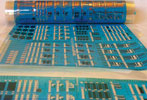

In the not all too distant future, polymer electronic circuits - in other words, microchips made of plastic that can be manufactured inexpensively using large-area printing processes - will be such a part of everyday life that it will be hard to imagine the world without them. Researchers, developers and production specialists from the electronics industry are convinced that this will be the case, as are politicians, associations, and market forecasters.
At Productronica 2005, a partial production line for manufacturing polymer electronics (a 'poly line') was set up at the VDMA pavilion (German Engineering Federation). This exhibit demonstrated an example of how the seven production steps for this technology of the future are implemented. Visitors were able to see for themselves that finished products made with polymer electronics will function for the mass market.
The basic requirement for the inexpensive production of flexible polymer electronic circuits is the interplay between additive printing techniques, as is the case with screen printing using the 'roll-to-roll' processing of polymer films - a technique that can already be mastered today on an industrial scale.
At the demo, the production of an all-polymer ring oscillator on 200 mm wide roll of PET film with 0,5 μm copper metallisation was presented. In order to realise the flexible polymer transistors and logic circuits that have drain-source structures with a channel length of 20 μm, the first step is the structuring of the copper metallisation. In the second step, the polymer semiconductor materials are deposited, then the polymer gate dielectric. After the screen printing of the gate electrode (step 4) and the application of the interdielectric, the vias (the through holes that go through the layers) are opened. Finally, in the seventh step, the silver conducting paste is applied through screen printing. Once these steps are accomplished and the completed circuit has run through the poly line, it is inspected on a testing station to ensure proper functioning.
Plastic replacing silicon
Functional polymers with an optimised chemical structure open up possibilities for manufacturing diverse electronics applications within a limited performance range.
Due to their numerous advantages - such as their low cost, flexibility, light weight, impact resistance and ease of processing - organic materials (particularly polymers) are already being widely used today in electronics as passive materials in the form of substrates, bonding agents, dielectrics or, for example, printing pastes. With organic semiconductors, these advantages can also be used for the inexpensive integration of electronic functions without mounting. This is because the scope of characteristics can be expanded significantly by adding nano particles.
For this reason, future polymer electronics will make it possible to produce simple, flexible systems with active components (such as transistors, antennas, displays or batteries) using well-known, time-proven, and cost-effective additive printing techniques that employ high-yield roll-to-roll processes. In this way, they open up possibilities for manufacturing inexpensive 'disposable electronics' for the mass market, and thus make it possible to tap into a billion dollar market.
Conceivable applications range from intelligent clothing labels or ID tags and ID labels (referred to as 'cent labels') to smart tickets (for travel, sports and cultural events, etc), paper toys, greeting cards, and chip cards with displays. The possibilities also include security elements in bank notes and extend all the way to electronic postal stamps and 'smart' medical bandages.

© Technews Publishing (Pty) Ltd | All Rights Reserved